Wondering what to eat in Japan?
This list of the top 50 most popular Japanese food should help for your next visit to the Land of the Rising Sun!
There are so many delicious foods to try in Japan, but it can be overwhelming if you don’t know what’s what or if the menu isn’t written in English.
This Japan food guide will give you the basics of what you need to know about the best food to eat in Japan.
Dishes that are vegetarian-friendly or have a vegetarian version are noted with “[V].”
Disclosure: This post contains affiliate links. By making a purchase through one of the links, I may receive a small commission at no extra cost to you. Thank you for your support and for helping me keep this blog up!
[joli-toc]
Seafood Dishes (海鮮料理)
1. Sashimi (刺身)
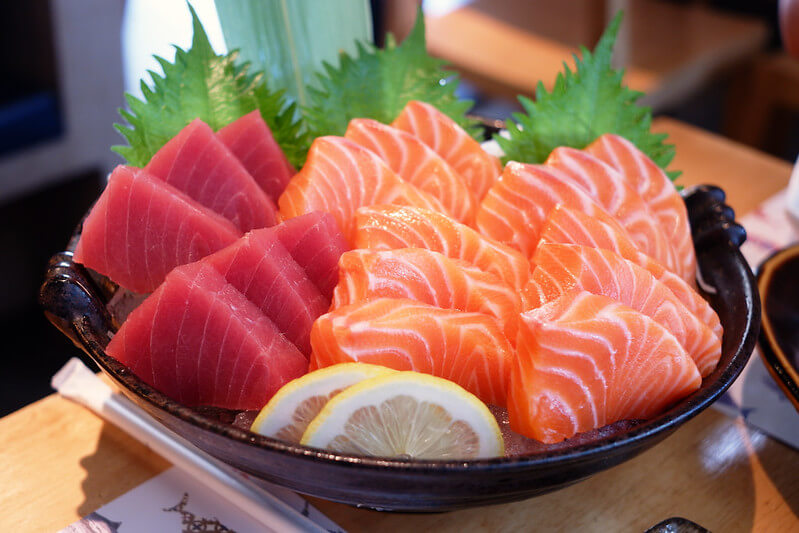
One of the most popular food you must eat in Japan is, of course, sashimi.
Sashimi is thinly sliced raw seafood or meat (yes, you read that last part correctly).
Although the terms “sashimi” and “sushi” may be used synonymously for casual admirers of Japanese cuisine, there is a distinct difference.
Sashimi does not include anything except the fish or meat, daikon radish, garnishes, and fresh ginger served with soy sauce and wasabi.
Sushi, as you’ll see next, is any dish that is made with vinegared rice.
The most popular types of sashimi include the following:
- Tuna: Maguro (まぐろ)
- Fatty Tuna: Ōtoro (おおとろ)
- Salmon: Sake (鮭)
- Yellowtail: Hamachi (はまち)
- Mackerel: Saba (さば)
- Shrimp: Ebi (えび)
- Salmon Roe: Ikura (いくら)
- Octopus: Tako (たこ)
- Squid: Ika (いか)
- Sea Urchin: Uni (ウニ)
2. Sushi (すし, 寿司, or 鮨) 🍣
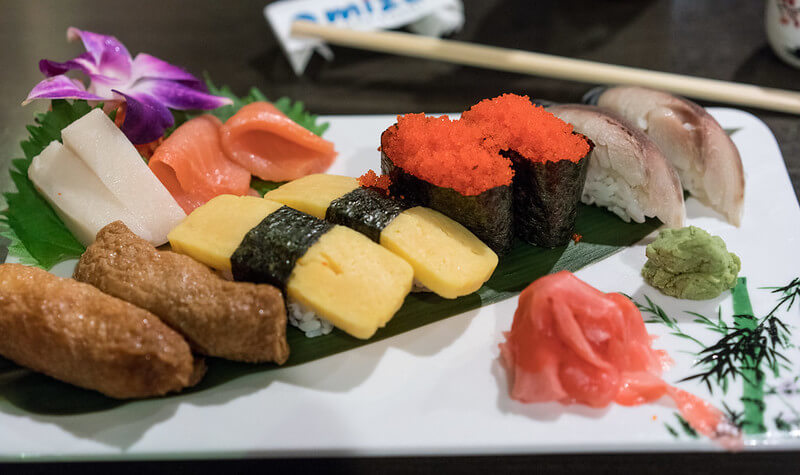
Japan’s national dish, sushi, is a dish that uses vinegared rice.
This special rice (sushi-meshi) is made from rice vinegar, sugar, and salt.
The rice-based dish comes in a variety of serving styles and types, such as:
Nigirizushi (握り寿司)
Meaning “Hand-pressed sushi,” nigirizushi is a small oblong ball of sushi rice topped with a piece of fish and sometimes wrapped with a very thin, belt-like strip of seaweed.
Gunkanmaki (軍艦巻)
Gunkanmaki is a hand-formed roll of sushi rice with a wide piece of seaweed wrapped around the entire perimeter. Finely chopped or small ingredients such as salmon roe are then placed on top.
Makizushi (巻き寿司) or Norimaki (海苔巻)
These are the familiar cylindrical rolls created with a bamboo mat.
Temaki (手巻)
Meaning “hand roll,” temaki is a cone-shaped sushi dish with a seaweed wrapping and opening at the wide end.
Oshizushi (押し寿司) or Hakozushi (箱寿司)
This pressed sushi is recognized by its square-shaped pieces formed via a wooden mold.
Inarizushi (稲荷寿司) [V]
A pouch of fried tofu filled with sushi rice.
Chirashizushi
Translating to “scattered sushi,” chirashizushi includes a variety of colorful ingredients over vinegared sushi rice.
Fun Fact: If “sushi” is the second word of a name, it turns into “zushi.”
3. Fugu
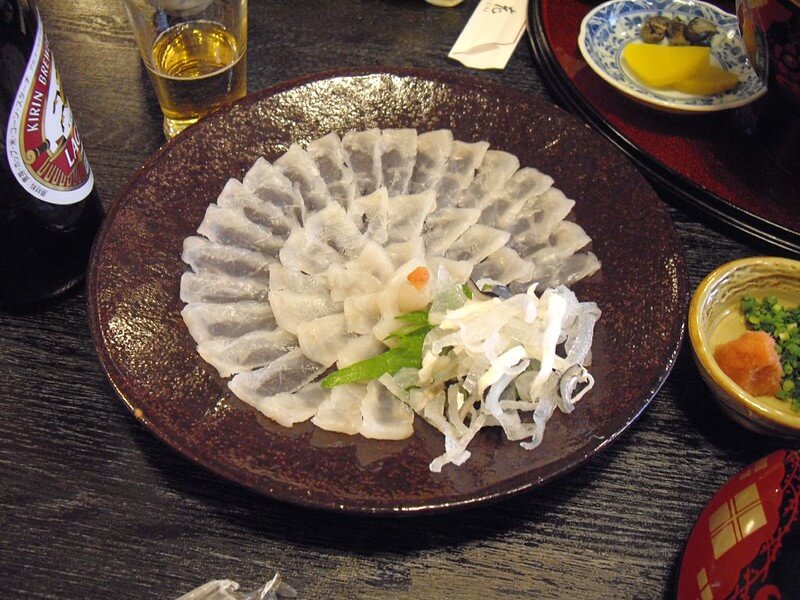
Fugu is pufferfish. Despite its lethal toxins, it’s a common item eaten regularly in Japan— most notably as sashimi.
Because of the dangerous consequences that occur if not handled properly, the deadly fish is required to be prepared by a licensed chef.
Today, fugu is not allowed to prepared in any home, and even the Japanese royal family is barred from eating it.
The fish itself has a very light and subtle flavor with a chewy texture.
4. Unagi (ウナギ)
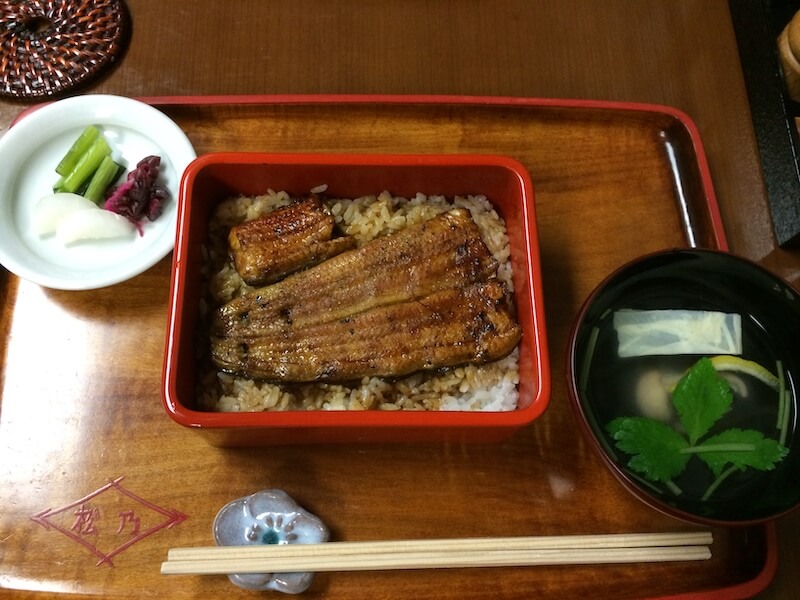
Contrary to what Ross Gellar of Friends believes, unagi is Japanese for freshwater eel and not, as he claimed, “a state of total awareness.”
Unagi is often served over rice or as a type of sushi.
Fun Fact: The karate term Ross was looking for was zanshin, which is the state of relaxed awareness.
5. Hitsumabushi

Hitsumabushi is a specialty eel dish from Nagoya.
It consists of grilled eel with a sweet sauce, a bowl of rice, dashi broth, and condiments (wasabi, shredded seaweed, and chopped spring onions).
How to eat Hitsumabushi
The regional favorite is eaten in a particular manner:
- Divide the contents of your rice bowl into four servings.
- Eat the first quarter as is, with the rice and eel.
- For the second quarter, enjoy it with the various seasoning.
- The third serving should be eaten with a bit of the soup (or tea in some restaurants) poured in.
- Finally, the last quarter can be enjoyed however you like.

Deep-Fried Dishes: Agemono (揚げ物 )
6. Tonkatsu (とんかつ )
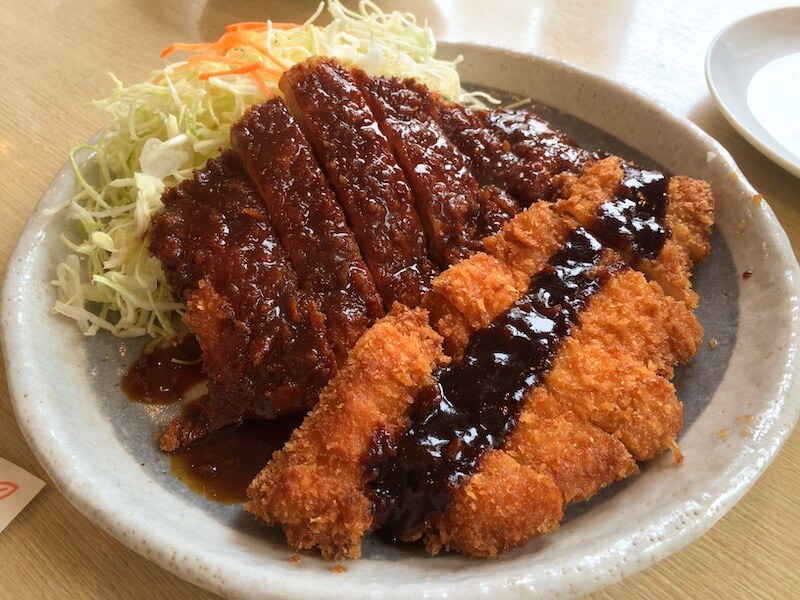
Tonkatsu is deep-fried Japanese pork cutlets.
The cutlets are pounded, seasoned, and breaded with panko before being deep-fried twice for a crispy yet tender finish.
The cutlets are usually served on a bed of shredded cabbage alongside rice as well as a sweet tonkatsu sauce.
7. Karaage (唐揚げ)
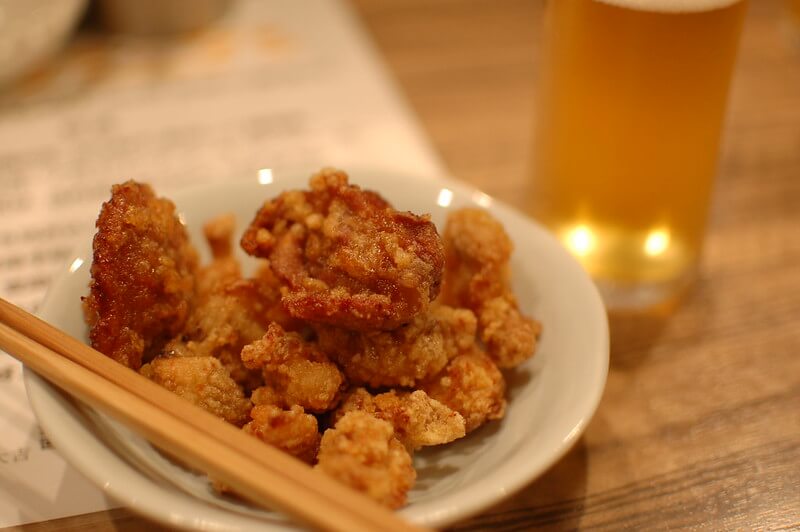
Karaage is Japanese fried chicken, typically made with boneless chicken thighs.
They’re small, bite-sized pieces served with a slice of lemon for a citrus zing.
The lightly battered and twice deep-fried item is popular as a side dish in bars, diners, bento meals, and even convenience stores.
The double fry method utilized in karaage and other fried Japanese dishes ensures a crispy exterior yet juicy interior.
8. Tempura (天ぷら) 🍤
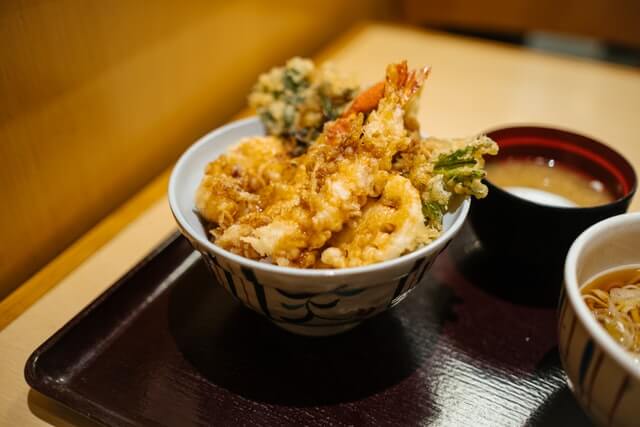
Tempura is seafood or vegetables deep fried in a specialty batter.
The most common tempura items include shrimp, eggplant, kabocha, mushrooms, and shiso leaves.
The dish is often accompanied by a tempura dipping sauce called tentsuyu, which is a combination of Japanese soup stock, soy sauce, mirin, and sugar.
9. Korokke (コロッケ)
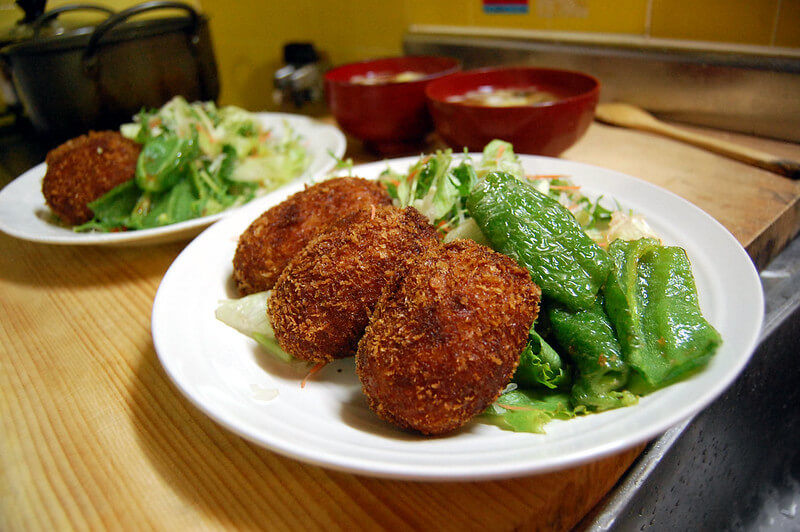
Korokke is a Japanese croquette made from ground meat and mashed potatoes.
The mixture is shaped into small patties, coated in breadcrumbs, and then deep-fried for a crispy result.
There are many variations of korokke, with some modifying the meat for seafood such as crab or adding curry powder for a flavor kick.
Grilled and Pan-Fried Dishes: Yakimono (焼き物)
10. Yakitori (焼き鳥)
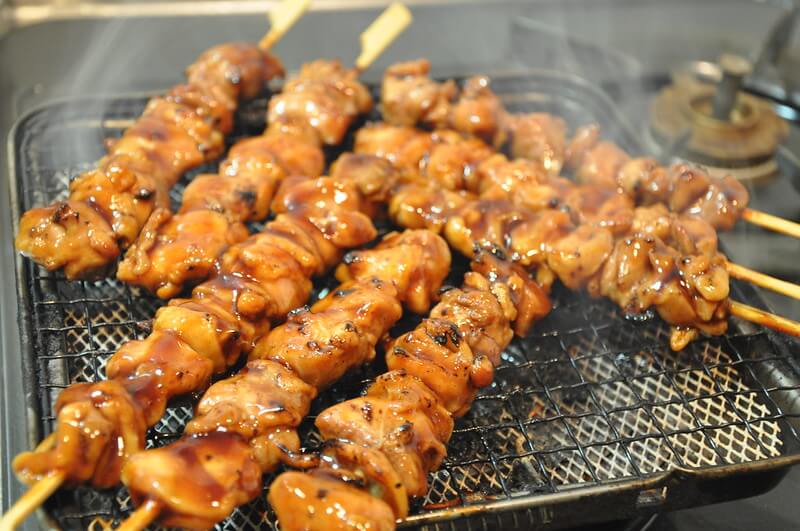
Yakitori is grilled chicken that’s served on skewers.
It’s an izakaya (bar) favorite that comes in a seemingly endless selection of chicken meat and sauces.
If you go to a yakitori restaurant in Japan, you’ll be able to choose from more familiar parts of the chicken (wings, breast, and thigh) to lesser-known parts for those with Western palates (heart, liver, or gizzard).
11. Yakiniku (焼肉)
Yakiniku translates to “grilled meat,” and is the Japanese version of barbecuing meat and vegetables.
At yakiniku restaurants, the raw ingredients are usually brought to the table where a grill is built in.
Diners then cook several pieces at a time and enjoy it with dipping sauces that include a mix of soy sauce, sake, mirin, and sugar.
12. Okonomiyaki (お好み焼き)
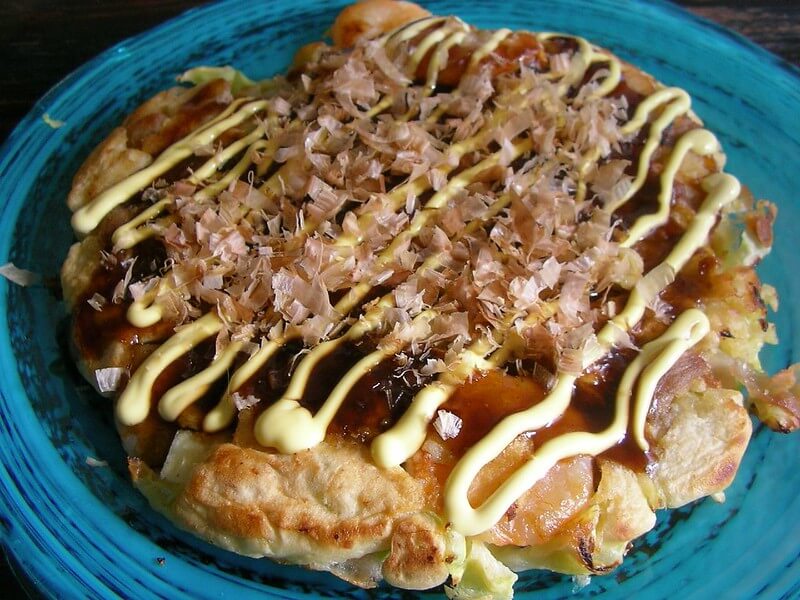
Okonomiyaki is a savory Japanese pancake and popular street food from the region of Osaka.
Its ingredients include shredded cabbage, eggs, and meat, and is topped with a medley of condiments such as Japanese mayonnaise, a sweet okonomiyaki sauce, and dried bonito flakes.
Like many other traditional dishes in Japan, different regions and prefectures have their own take on the original recipe.
In Hiroshima, you can find one of the most popular versions of okonomiyaki which includes layering in a fried egg as well as yakisoba noodles.
13. Monjayaki (もんじゃ焼き)
Monjayaki is a savory pancake similar to okonomiyaki but uses different ingredients in the batter.
The mixture is a runnier consistency compared to okonomiyaki because it includes additional dashi broth.
Other ingredients such as cabbage and seafood or meat are combined with the batter and then cooked on an iron griddle tableside.
Toppings can also be added, including cheese or mochi.
14. Gyoza (餃子) 🥟
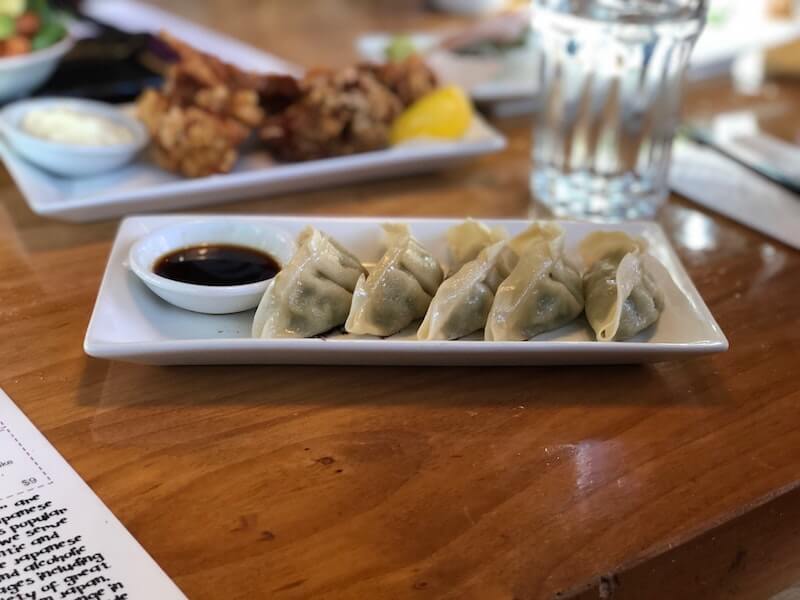
Gyoza is a pan-fried dumpling filled with ground meat and vegetables, and eaten with a simple dipping sauce.
The cooking method of both pan-frying and steaming the dumplings results in a crispy bottom yet juicy filling.
Unlike Chinese potstickers, Japanese gyoza are typically smaller and made from thinner skin.
15. Takoyaki (たこ焼き)
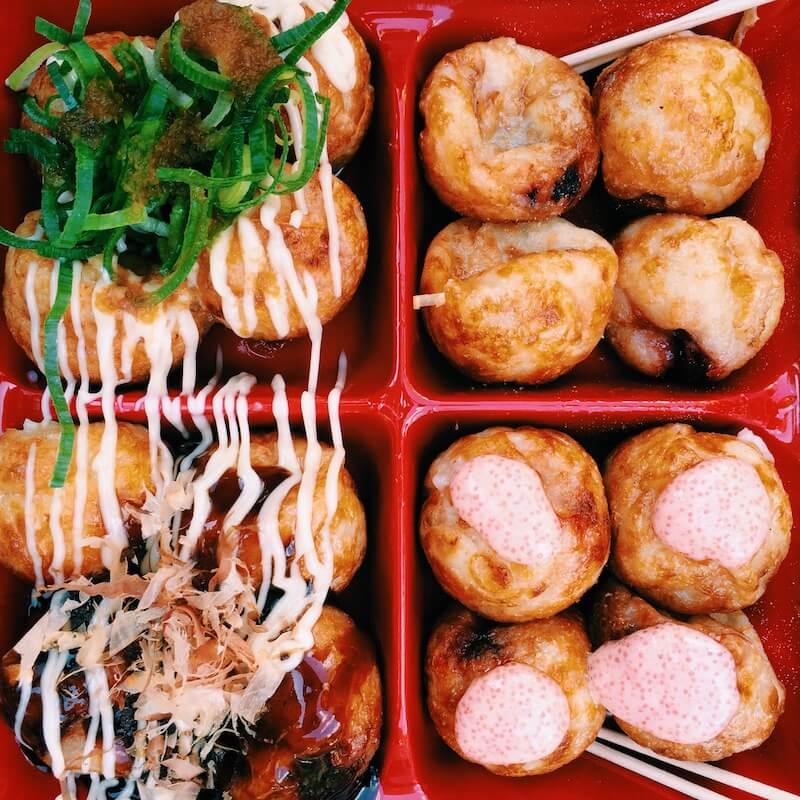
Takoyaki is a fried octopus ball and one of Japan’s most popular street food.
Originally from Osaka, the small dumplings come with a piece of octopus inside the dough and topped with a special sauce and variety of garnishes.

Meat Dish: Niku Ryōri (肉料理)
16. Kobe Beef (神戸ビーフ)
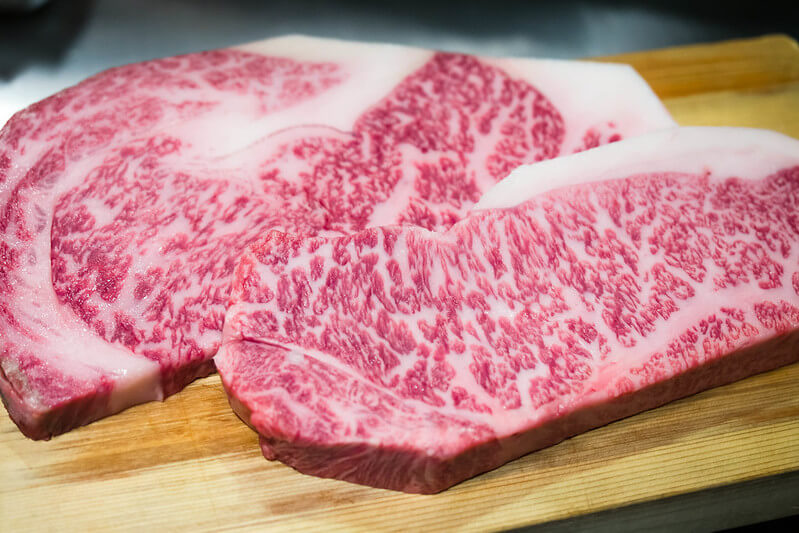
Kobe beef is a delicacy, and usually pretty pricey due to its high quality and strict standards.
Only 3,000 cattle typically qualify as Kobe each year.
In order to be certified as Kobe Beef, the Wagyu beef must meet a set of criteria, which includes the following:
- Of the Tajima cattle breed
- Born, raised, and processed in Japan’s Hyogo prefecture
- Meat quality score of at least Grade A4
- Beef Marble Score (BMS) of at least 6
- Gross weight of meat from a single cattle no more than 499.9 kg.
It’s worth noting that outside of Japan, some meat is marketed as “Kobe-style beef,” or as often the case in America, simply labeled “Kobe beef.”
The cattle might be Wagyu and imported from Japan, but they could be crossbred and are not the authentic or certified Kobe Beef found in Japan.
One-Pot Dishes: Nabemono (鍋物)
17. Sukiyaki (すき焼き)
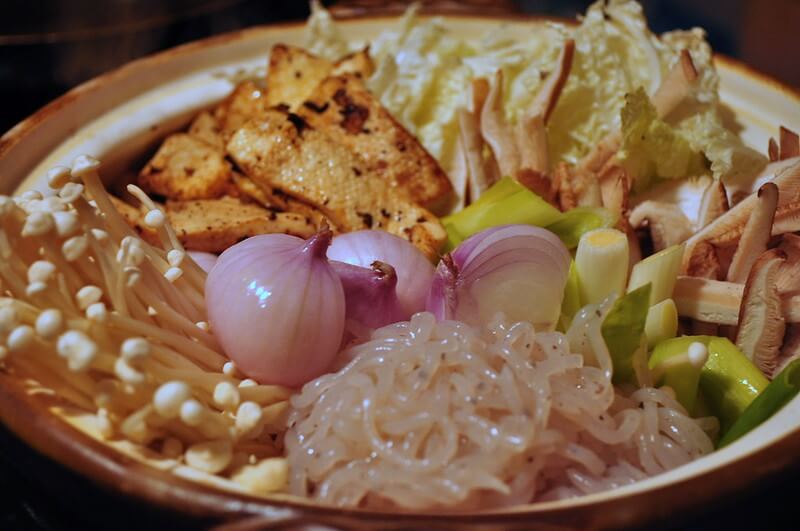
Rooted in Chinese cuisine and introduced to Japan via Osaka, Sukiyaki is a sweet and savory one-pot dish cooked tableside in a shallow skillet or pot, usually around the cold winter months, and includes thinly sliced beef and vegetables.
The most common non-meat ingredients that are often added are tofu, shiitake or enoki mushrooms, glass noodles, scallions, and napa cabbage.
The sukiyaki sauce, warishita, is primarily made from popular Japanese cooking ingredients such as sugar, soy sauce, sake, and mirin.
Depending on the region, there are different ways to top off the dish with a raw egg prior to serving.
In some places, it’s common to dip the cooked ingredients in raw egg just before eating.
In other cities, a raw egg is broken and added on top of the simmering pot before being served.
18. Shabu Shabu (しゃぶしゃぶ)
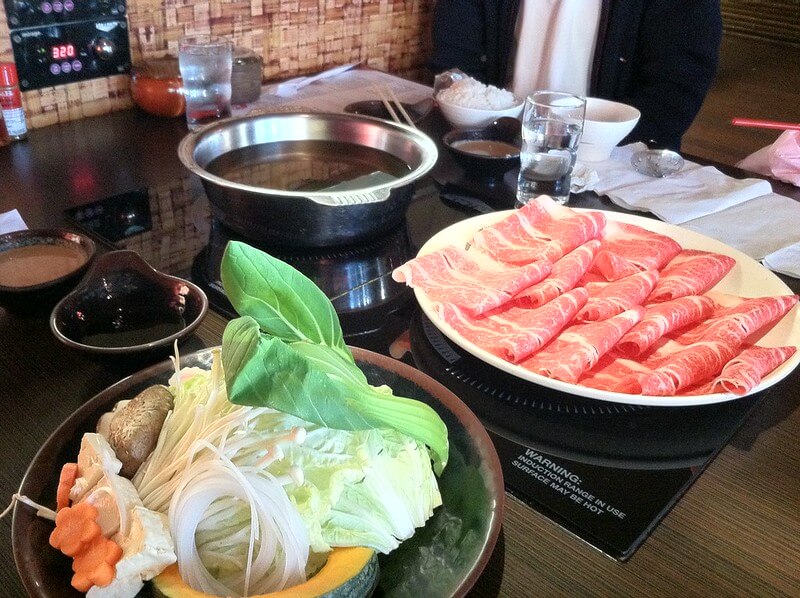
Shabu shabu is similar to sukiyaki and can easily be confused for it as they are both single pot dishes cooked at the table.
The key differences, however, are that shabu shabu leans more toward savory than sweet, and is cooked in a traditional hot pot of boiling water or broth.
The overall flavors are lighter compared to sukiyaki as the latter involves a sauce and no broth.
So what is shabu shabu?
It’s a hot pot dish that includes thinly sliced beef, udon noodles, and a variety of vegetables all cooked in a broth (kombu dashi).
The meat is typically swirled around in the boiling pot for just a few seconds until it’s cooked and then dipped in either ponzu or sesame seed sauce before eating.
Fun Fact: The phrase “shabu shabu” is onomatopoeic, meaning it comes from the “swishing” sound made while stirring the ingredients in the hot broth.
Stewed Dishes: Nimono (煮物)
19. Oden (おでん) 🍢

Oden in a winter one-pot dish that includes a variety of hearty items such as fish balls, fish cakes, konnyaku, tofu, vegetables, and more, all cooked in a savory broth.
Also referred to as Japanese fish cake stew, the comforting meal is traditionally prepared and simmered in a donabe, or earthenware pot.
This warm dish is perfect for the cold winter months, from light snow in Tokyo to heavy storms in Hokkaido.
20. Nikujaga (肉じゃが)
Nikujaga is a meat and potato stew.
It includes thin slices of beef, onion, potatoes, vegetables, carrots, and konnyaku noodles simmered together in a savory and sweet broth.
The comforting meal is a popular home-cooked dish and perfect for cold days!
Soup: Suimono (吸い物)
21. Miso Soup (味噌汁) [V]
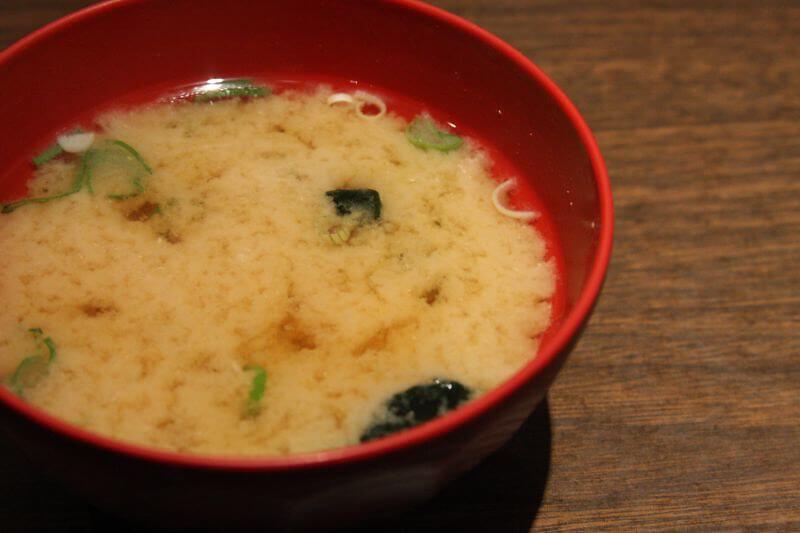
Miso soup is a staple in Japanese meals, often served alongside a bowl of rice.
The simple yet healthy broth is made with miso soybean paste, dashi soup stock, tofu, seaweed, and green onions.
Rice Dishes: Gohanmono (ご飯物)
22. Omurice (オムライス) [V]
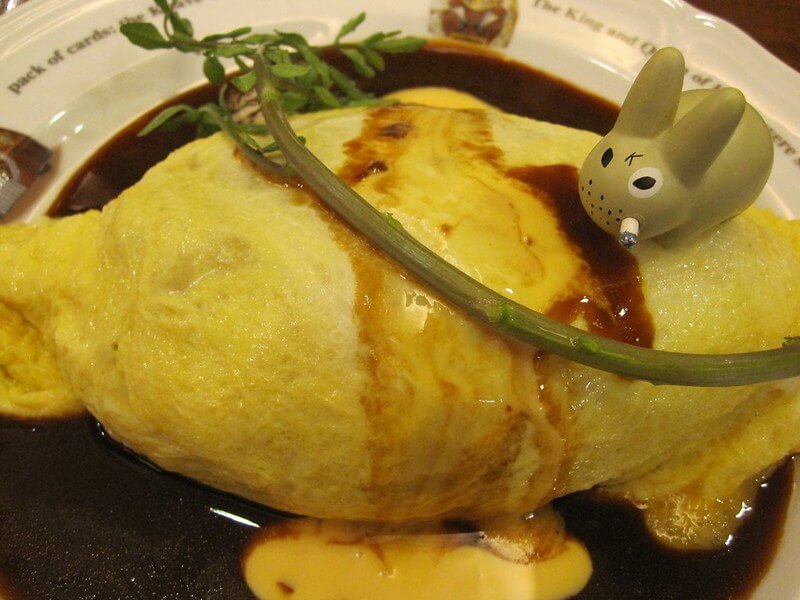
Omurice is a Westernized dish that consists of an egg omelette over fried rice (omlette + rice= omurice).
It’s usually covered in ketchup or demi-glace sauce.
It’s you’re wondering what to eat in Japan for picky eaters, this might be it.
23. Onigiri (おにぎり) [V] 🍙
Onigiri is a Japanese rice ball that comes in a variety of shapes, designs, and tastes.
They can either be formed in a triangle or sphere and wrapped in dried seaweed or other toppings.
The most common types of onigiri you’ll find are stuffed with the following:
- Tuna and Japanese mayonnaise
- Umeboshi (Japanese pickled plum)
- Salmon
- Tarako (Salted cod roe)
Unlike sushi, the rice used in onigiri is simply steamed, not vinegared.
Onigiri are great for snacks especially, and you’re guaranteed to find them in every convenience store.
Fun Fact: If you do buy onigiri from a convenience store, look closely at the wrapper and you’ll see labeled step for the order in which to unwrap the rice ball.
If you do it correctly, the seaweed will wrap perfectly around the onigiri, leaving your fingers unstickied!
24. Japanese Curry or Curry Rice (カレーライス) 🍛
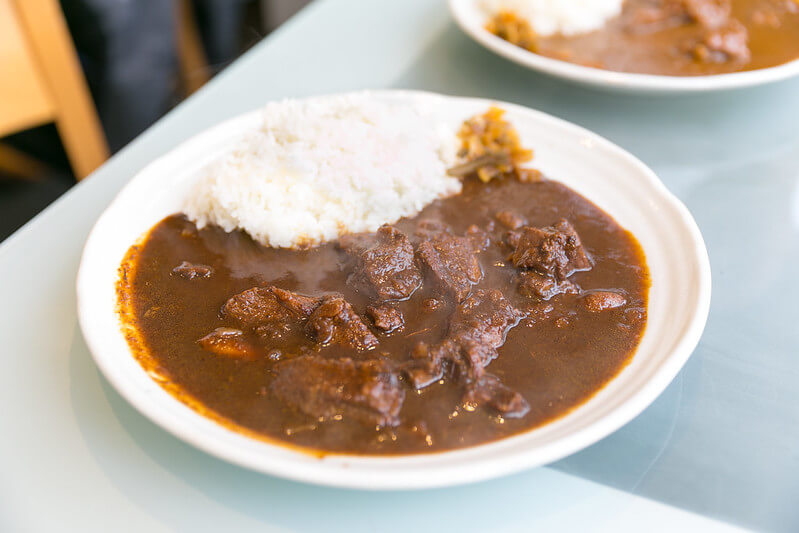
Japanese Curry has the consistency of gravy and is typically milder and sweeter compared to Indian curry.
It can be made from either chicken, pork, or beef, and includes a number of base vegetables such as onions, carrots, and potato.
Japanese curry is often called curry rice because the two items are served together as one dish.
If you go to a curry restaurant in Japan, you’ll usually be able to choose your desired level of spiciness.
25. Donburi (どんぶり or 丼)
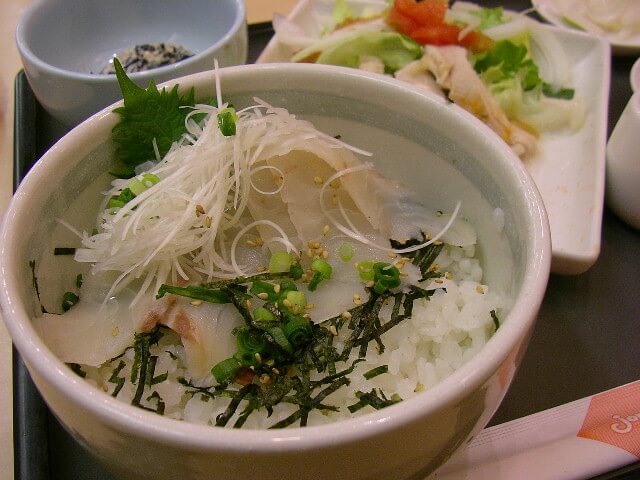
Donburi is a Japanese rice bowl dish that consists of meat, fish, or vegetables served over rice.
A sauce might also be incorporated into the dish for a savory and filling meal.
There are many types of donburi, but the most popular include katsudon, gyudon, kaisendon, and oyakudon.
See what these rice bowl dishes are below.
Fun Fact: “Don” (丼) means “bowl” in Japanese, so anytime you see an item with this suffix, you’ll be able to recognize it as a rice bowl dish.
26. Katsudon (カツ丼)

Katsudon is a dish that comes with a panko-breaded deep-fried pork cutlet, egg, and vegetables over a bowl of rice.
27. Gyudon (牛丼)
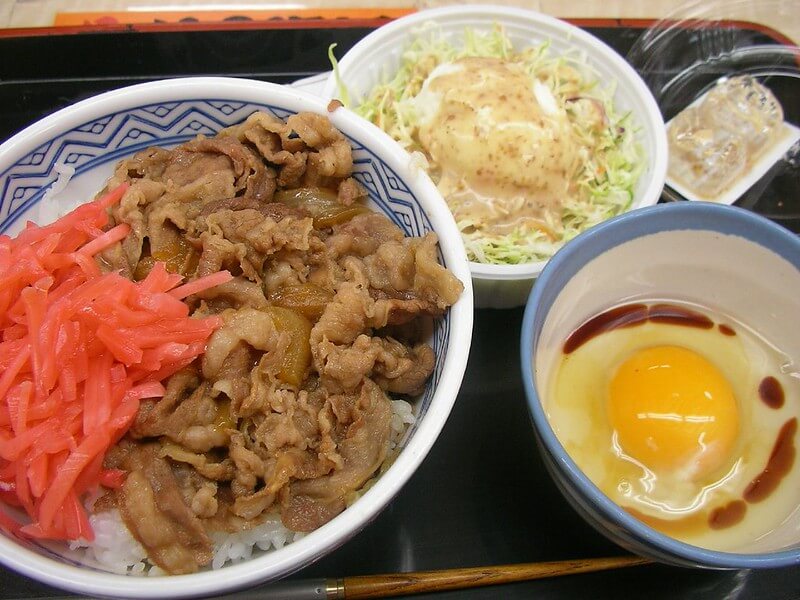
Gyudon is a Japanese beef and rice bowl with thinly sliced pieces of beef and onion served over hot, steamed rice.
It’s a favorite and fast comfort meal that is both nutritious and filling to eat.
In Japan, oftentimes gyudon is served with a raw egg yolk on top of the simmering beef which is then mixed into the dish just prior to consuming.
28. Kaisendon (海鮮丼)
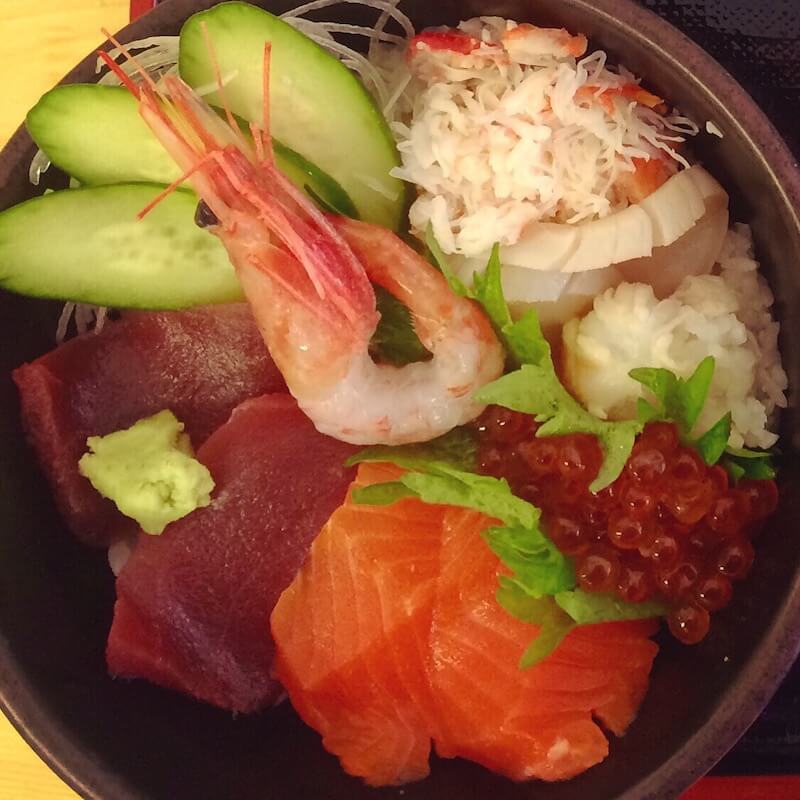
Kaisendon is a seafood rice bowl that includes raw seafood (sashimi) over steamed rice.
While chirashizushi might seem similar to kaisendon, the difference is the type of rice used.
Chirashizushi uses vinegared rice and kaisendon uses steamed rice.
The colorful dish can come with an array of seafood options.
If you’re looking for the best kaisendon in Japan, plan a visit to Hokkaido.
The seafood in Hokkaido is considered to be some of the freshest in the country due to the cold waters in the area, making it a foodie favorite.
29. Oyakodon (親子丼)
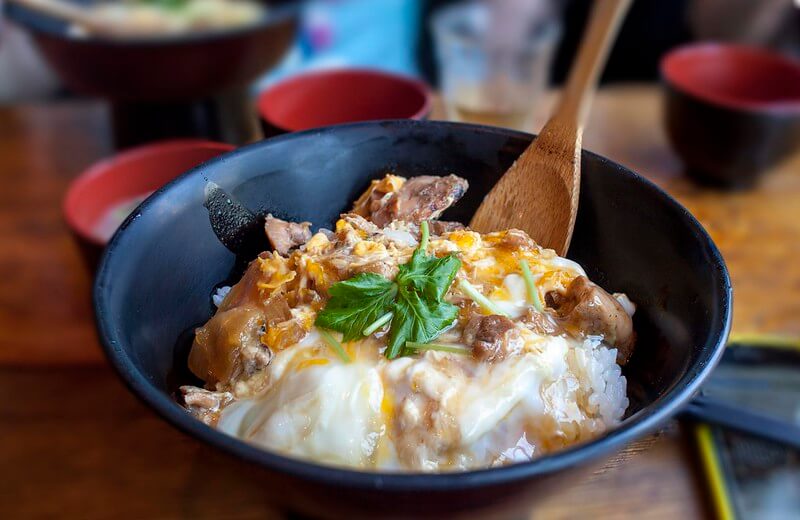
Oyakodon is a rice bowl dish that includes chicken, egg, and scallions simmered together with a broth and served over rice.
30. Ochazuke (お茶漬け)
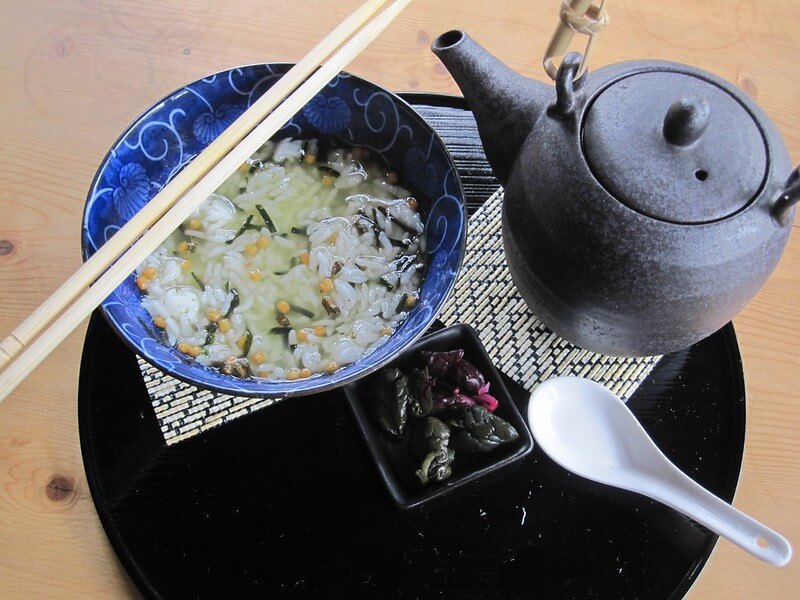
Ochazuke is a simple and quick comfort meal that includes rice and a few ingredients submerged in tea or dashi broth.
Some popular Ochazuke toppings include seaweed, umeboshi, salmon flakes or roe, and sesame seeds.
Noodle Dishes: Menrui (麺類)
31. Soba (そば) [V]
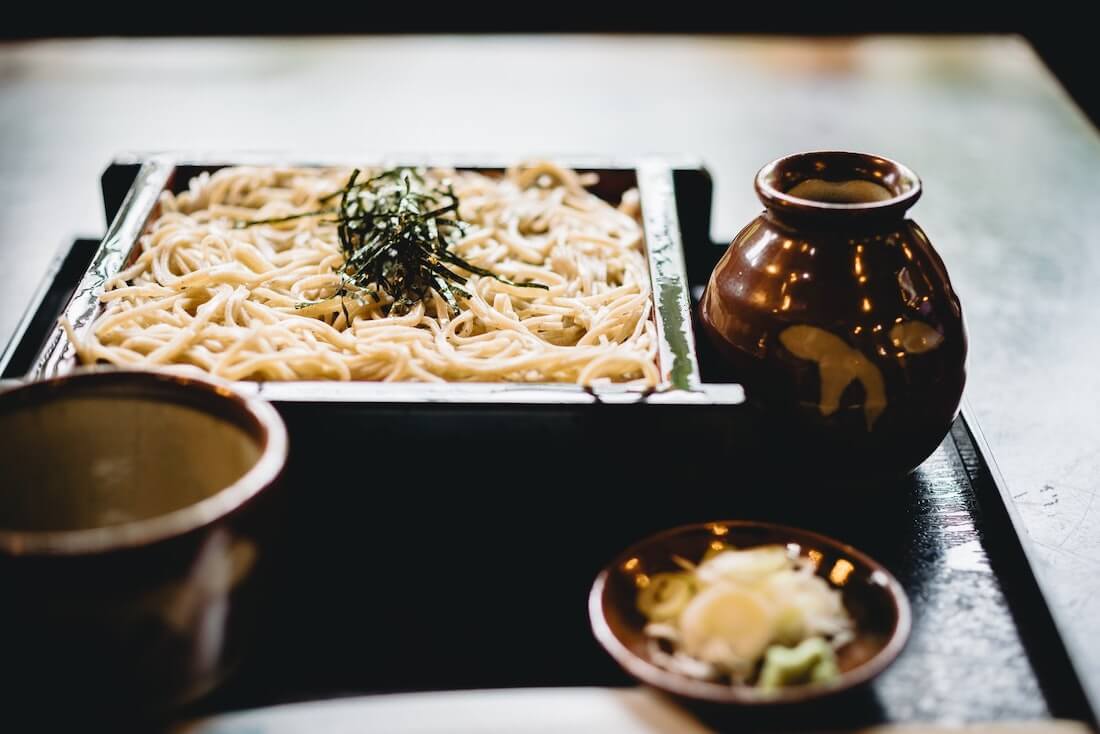
Soba is a thin buckwheat noodle that is eaten either chilled (zaru soba) with a dipping sauce or hot in a broth.
Zaru soba is a summer favorite to cool down from the heat.
32. Udon (うどん) [V]
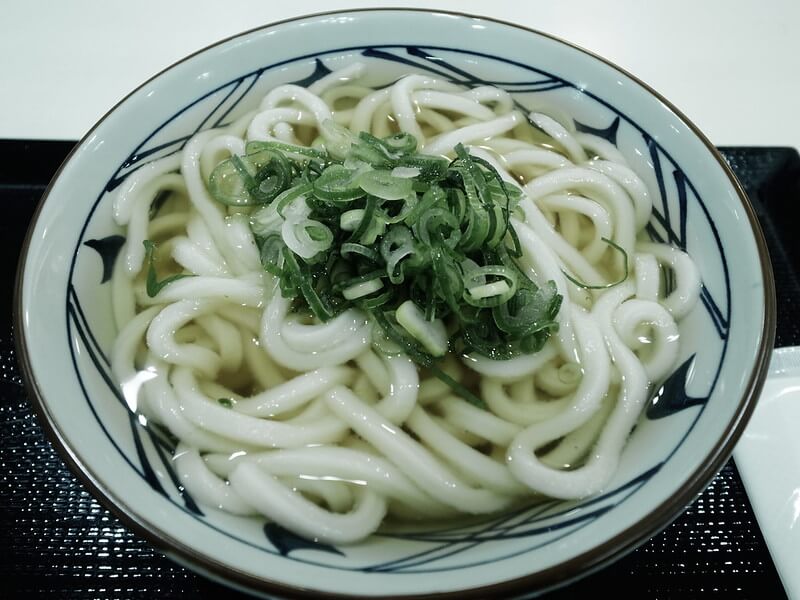
Udon is thick, Japanese noodles made from wheat flour that can be enjoyed both chilled with a dipping sauce or hot in a soup like soba.
There are several regional varieties and kinds of udon dishes that incorporate different ingredients into the udon meal.
These include:
- Curry Udon (カレーうどん): Hot udon served in curry
- Tanuki Udon (たぬきうどん): Udon served with deep-fried tempura batter
- Tsukimi Udon (月見うどん): Hot udon served with a raw egg on top
- Tempura Udon (天婦羅うどん or 天ぷらうどん): Udon served with pieces of tempura
33. Ramen (ラーメン) 🍜
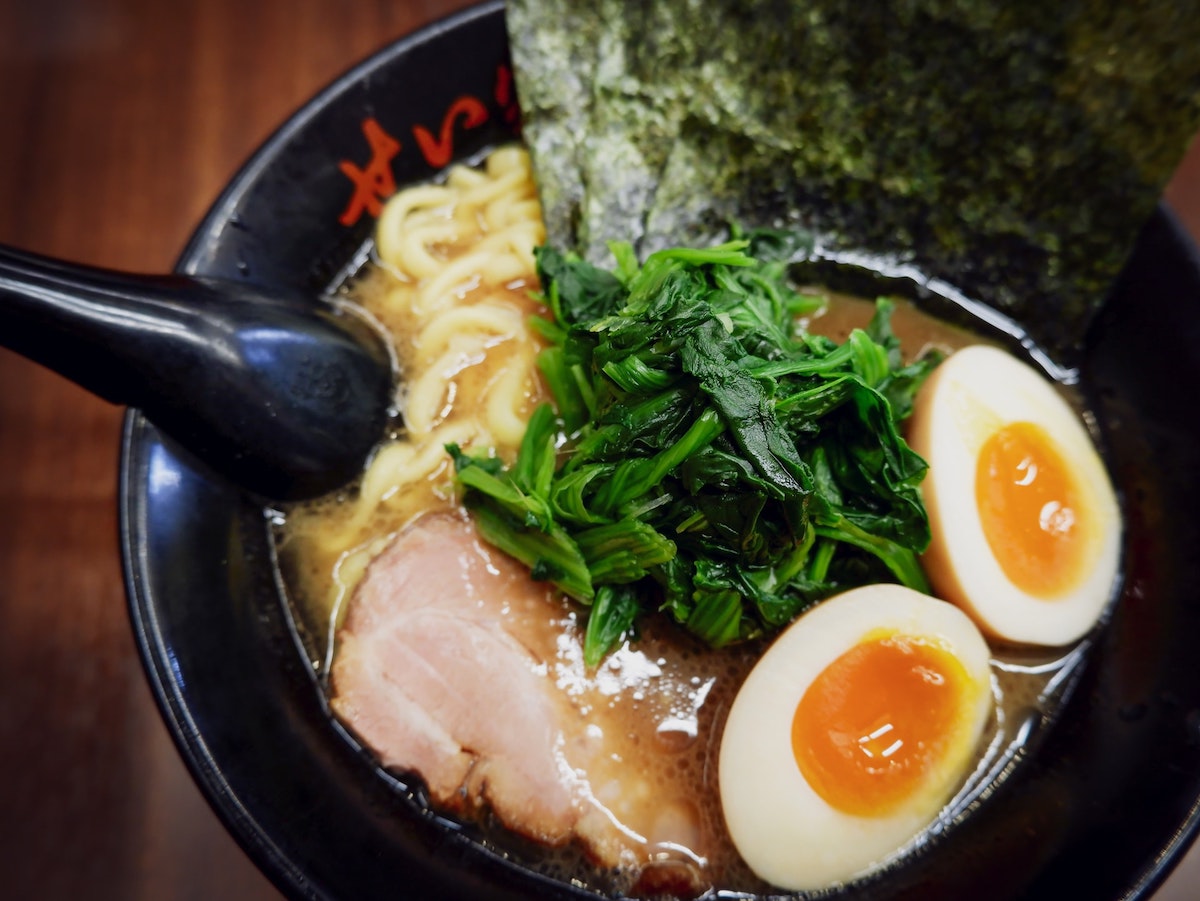
Ramen is a noodle soup that has many variations across the country.
The soupy meal comes in endless combinations of broths, flavors, and ingredients.
The most popular types of ramen bases include the following:
- Shōyu ramen (醤油, “soy sauce”)
- Shio ramen (塩, “salt”)
- Miso ramen (味噌)
- Curry ramen (カレー)
34. Yakisoba (焼きそば)
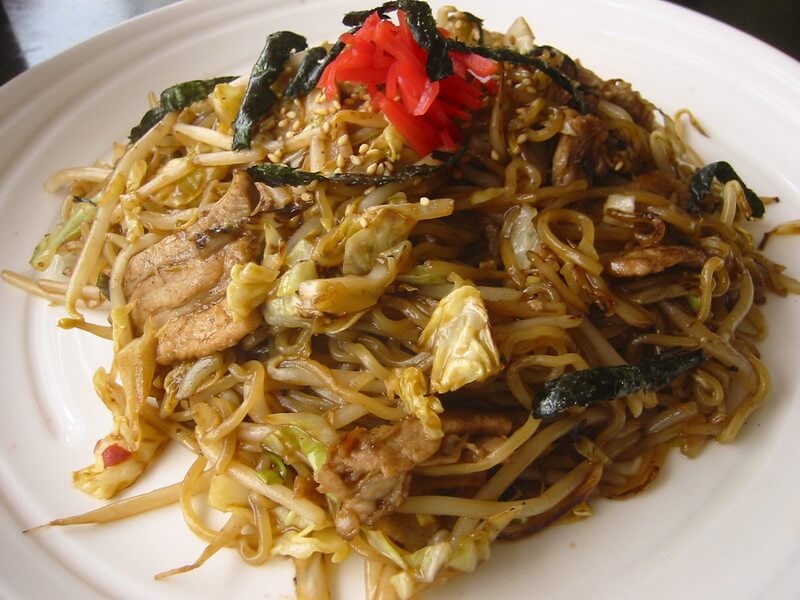
Yakisoba is Japanese stir fry noodles that include a combination of proteins and vegetables as well as a sweet sauce.
In addition to finding yakisoba at diners, it’s often a favorite item offered at food stalls during festivals.
35. Champon (ちゃんぽん)
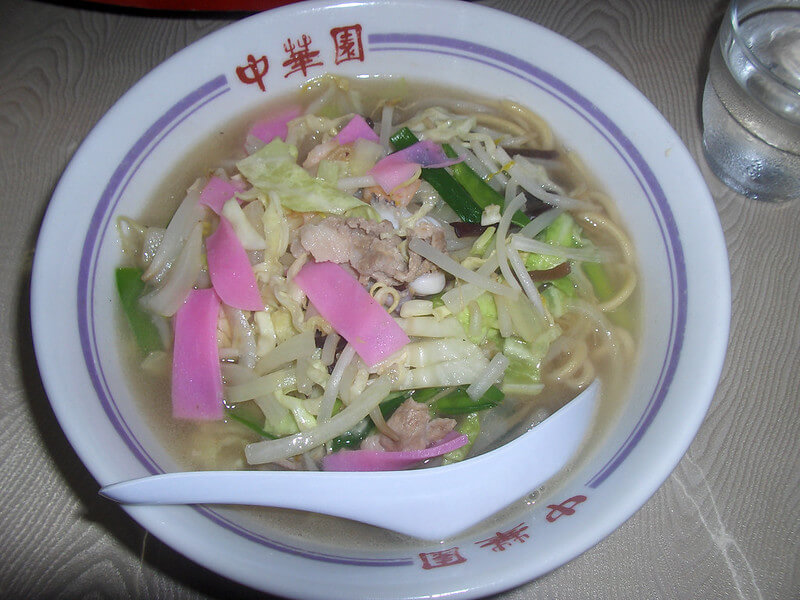
Champon, also called chanpon, is a soupy noodle dish originally from China and was first introduced to Japan in Nagasaki.
The hot dish includes fried pork, seafood, and vegetables served with ramen noodles in a savory broth.

Bread: Pan (パン)
36. Melon Pan (メロンパン) [V]
Melon Pan is a sweet bread that has a crisp, cookie-like crust at the top with a grid design.
Contrary to what the name might seem to imply, the bread traditionally doesn’t have any melon flavor.
It’s believed that the pastry got its name because the design of the bread looked like an Asian melon.
“Pan” in Japanese means bread (borrowed from the Portuguese) resulting in the name melon pan.
Today, melon pan comes in a variety of flavors and styles.
Some are made with chocolate chips, matcha, or even pureed melon; others are filled with custard cream.
Japanese Sweets: Wagashi (和菓子)
37. Mochi (餅, もち) [V]
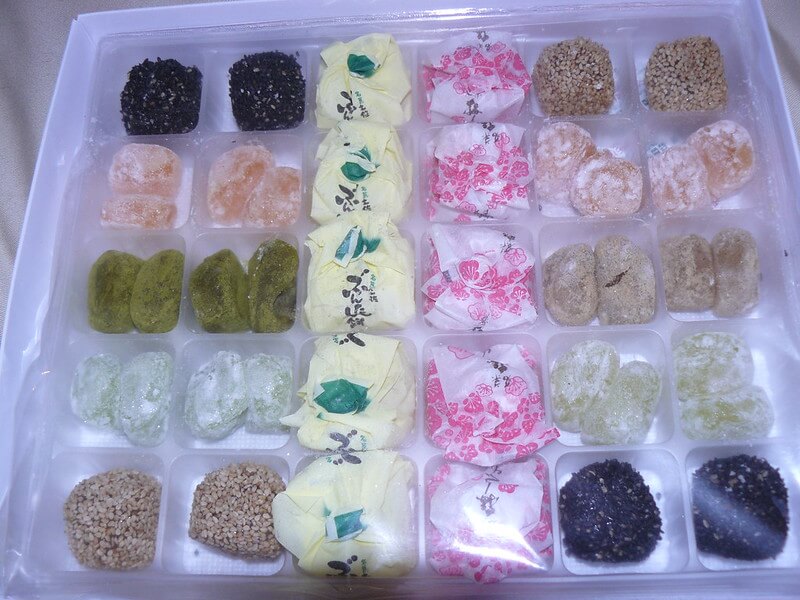
Mochi is Japanese rice cakes made from a glutinous rice that’s pounded into a paste and molded.
While it can be eaten year round, it’s a traditional item consumed during the New Year.
It’s a very sticky, chewy, and stretchy item that’s naturally white and can be enjoyed plain or flavored.
Flavored mochi usually come either filled with red bean paste (anko) or coated in a sweet soybean powder called kinako.
38. Dango (団子) [V] 🍡
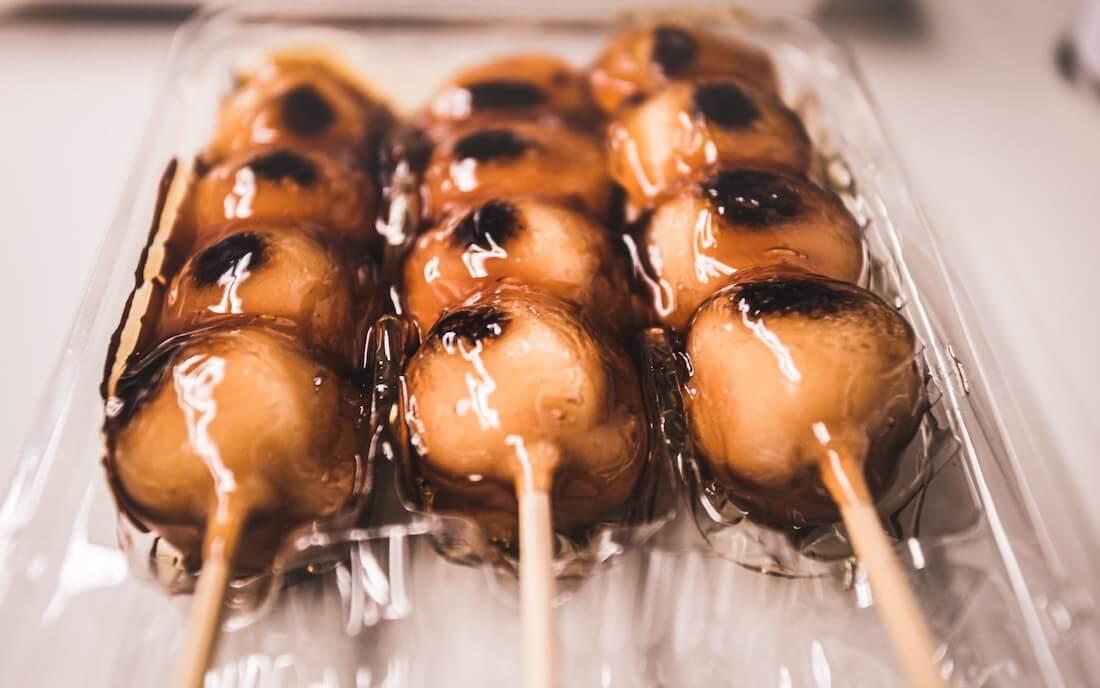
Dango is sweet rice balls that are typically served skewered and found at street stalls or festivals.
The soft and chewy treat might seem similar to mochi, but they are made with different ingredients.
While mochi is made from rice, dango is made from rice flour.
There are several kinds of dango, but the two most common types of dango you’ll see are mitarashi dango (みたらし団子) and hanami dango (花見団子).
Mitarashi dango are white dumplings covered with a soy sauce glaze. 3-5 are usually skewered on each stick.
Hanami dango are eaten in the spring during the cherry blossom viewing season and typically come in three colors: white, pink, and green (made with matcha powder).
The pink symbolizes the cherry blossoms in spring, the white represents snow in the winter, and the green depicts grass in the summer.
39. Manju (利休饅頭) [V]

Manju is either baked or steamed wheat buns with filling.
While the most common filling is red bean paste, the sweet buns can also include pastes made from chestnut, sesame, miso, or matcha.
40. Daifuku (大福餅) [V]
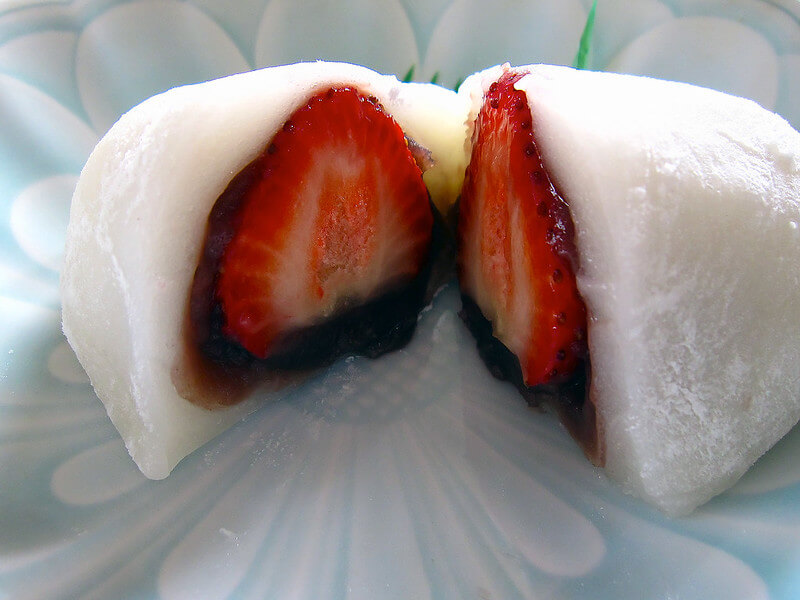
Daifuku is a small, filled mochi.
The confection is typically stuffed with red bean paste (anko) and comes in either white, light green, or pale pink.
These days, some popular variations of the treat include ichigo daifuku (strawberry filling) and coffee daifuku.
41. Taiyaki (鯛焼き) [V]
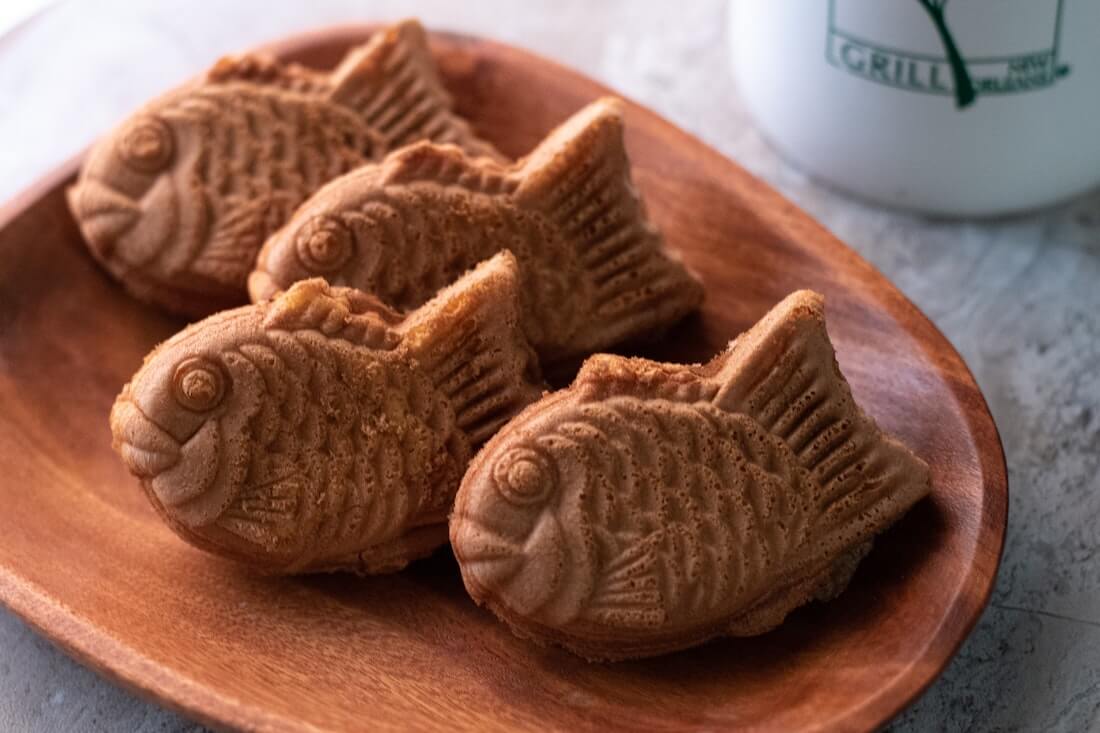
Taiyaki is a street food and snack that looks like a fish.
The baked cake is filled inside most commonly with red bean paste, but it can also have custard, cheese, or chocolate.
The batter is the same as waffle or pancake mix, but it’s poured into a special fish-shaped mold.
Pickled Dishes: Tsukemono (漬け物)
42. Umeboshi (梅干) [V]
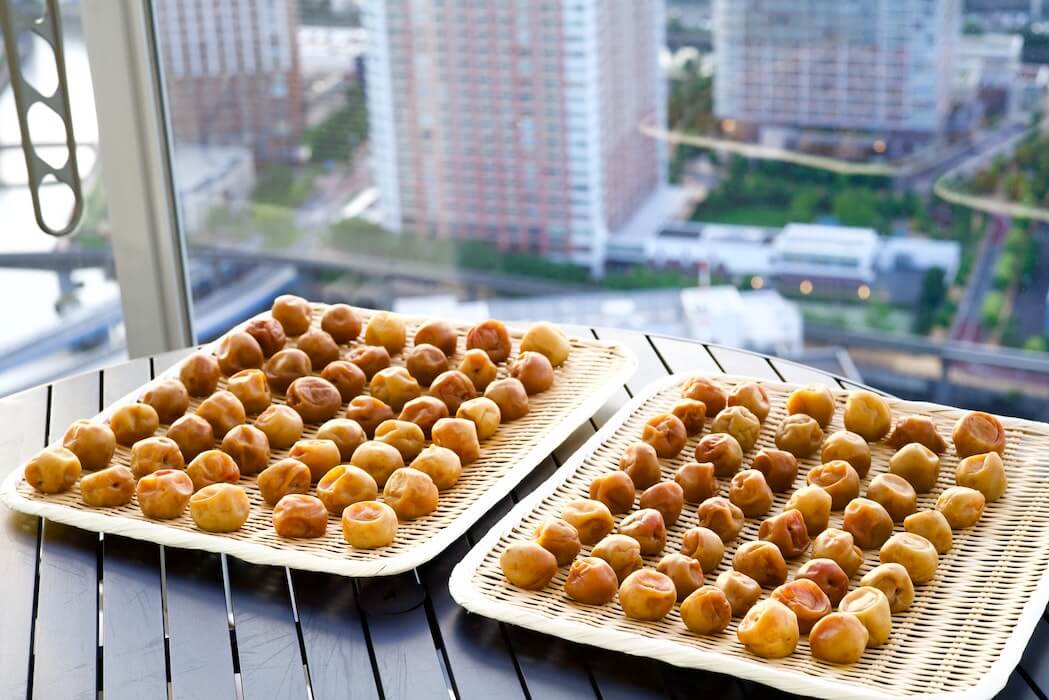
Umeboshi is a pickled plum that has both a sour and salty flavor profile.
It’s often eaten together with plain rice or rice-based dishes such as porridge, ochazuke, or in onigiri.
Side Dishes: Sōzai (惣菜)
43. Natto (納豆) [V]
Natto is fermented soybeans that’s served with soy sauce and mustard, and eaten with rice.
It’s a breakfast staple in Japan, but is known to be an acquired taste for those with Western palates.
It’s texture is stringy and slimey and often smells very strongly, making it a seemingly unappetizing dish.
However, the dish comes with a high amount of nutritional benefits and probiotics that improves digestion, promotes stronger bones and heart health, and could even strengthen your immune system.
44. Tamagoyaki (玉子焼き) [V]
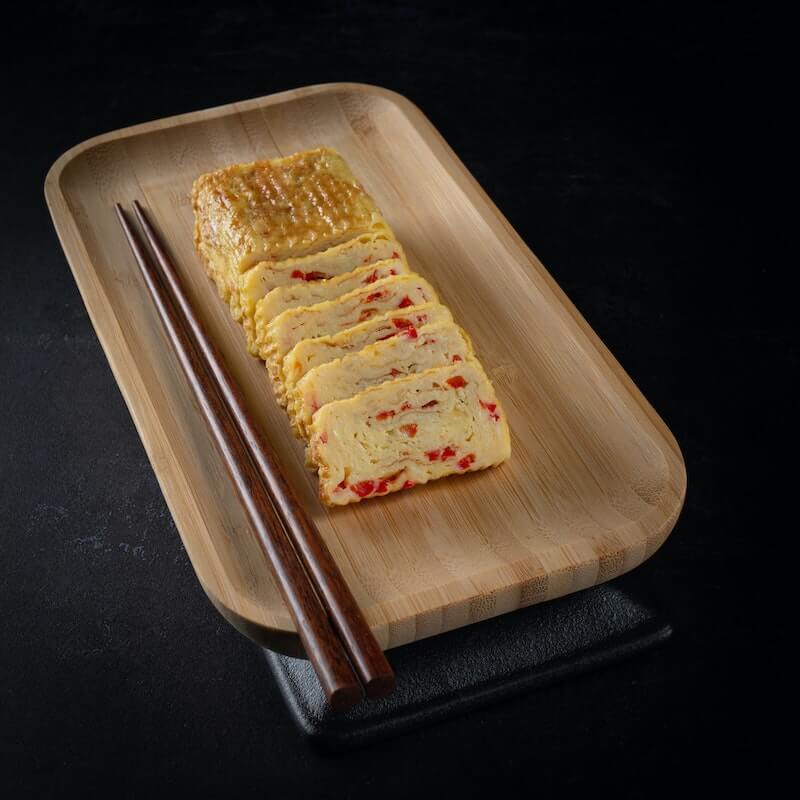
Tamagoyaki is a sweet rolled omelette usually featured as a side dish in bento lunches or Japanese breakfasts.
It’s made by slowly cooking thin layers of an egg mixture that consists of eggs, soy sauce, sugar, mirin, and salt.
The omelette can also be customized to include a variety of ingredients such as salmon flakes and vegetables.
Once each layer sets, they’re rolled until the final result looks like a log.
The tamagoyaki is then sliced and served.
45. Chawanmushi (茶碗蒸し)
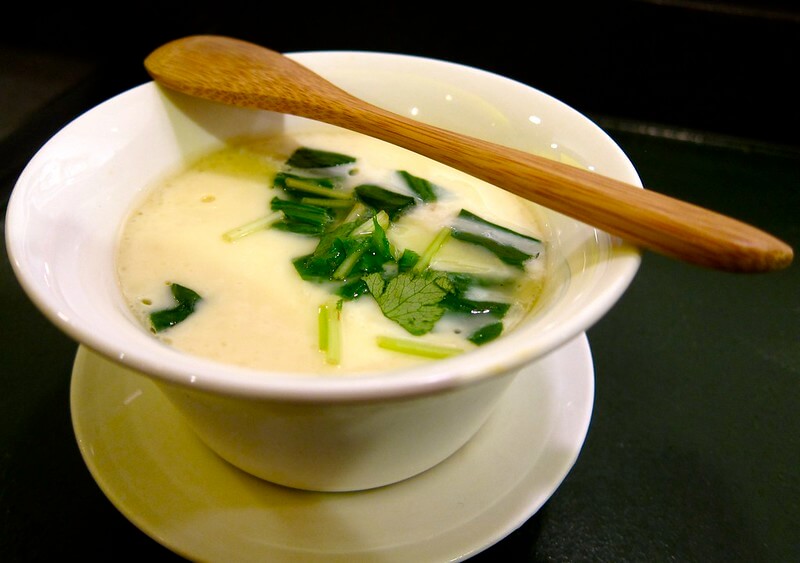
Chawanmushi is a steamed egg custard that’s usually served as an appetizer.
It comes in a small cup and includes a variety of ingredients like mushrooms, fish, and vegetables.
While the egg mixture settles into a pale yellow color, the colorful toppings add a nice contrast for a dish that’s appealing to both look at and eat.
46. Osechi (御節)
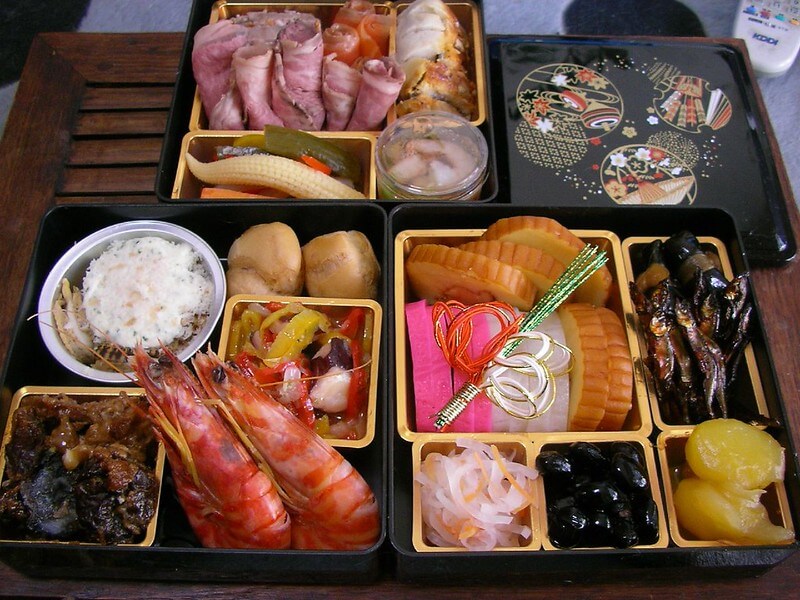
Osechi is a variety of traditional dishes eaten during the New Year.
They’re often sold in special bento boxes and the ingredients tend to be very colorful.
Each item symbolizes something different such as health or good fortune.
Tea: Ocha (お茶)
47. Matcha (抹茶) [V]
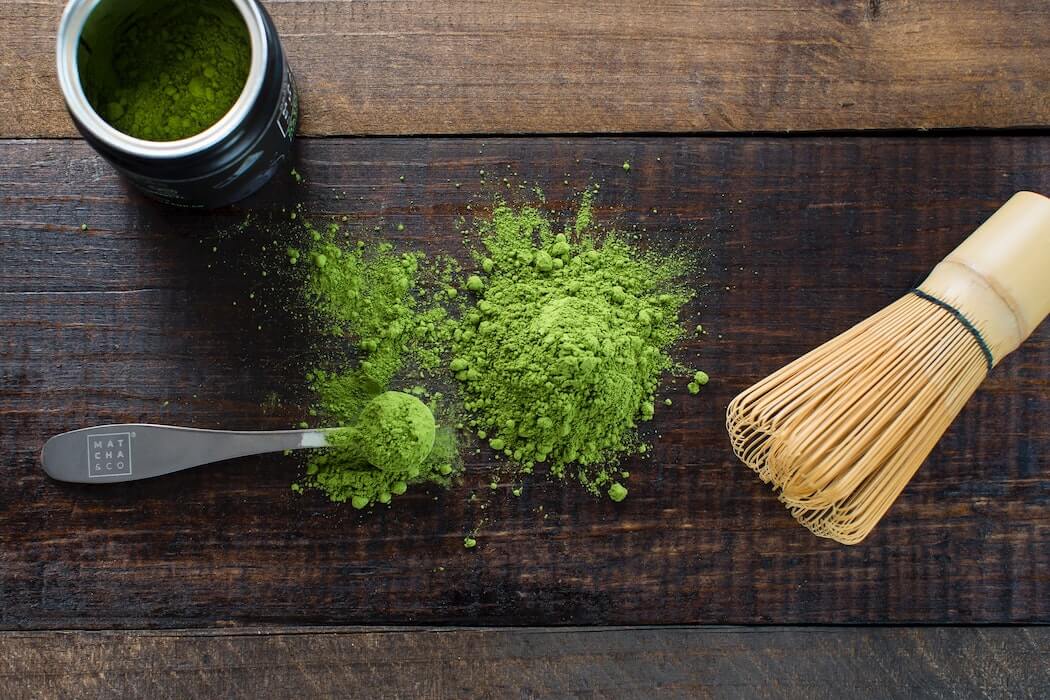
Matcha is a powder ground from green tea leaves.
The trademark green color and flavor is used for everything from traditional teas to sweets and desserts.
Matcha is known to have a host of health benefits such as preventing heart disease and promoting weight loss.
For the best matcha in Japan, head to Uji, Kyoto—the birthplace of the iconic powder.
Bonus points if you get to experience snow in Kyoto while enjoying a cup of matcha!
Set Meals
48. Bento or Obento (弁当, 御弁当) 🍱
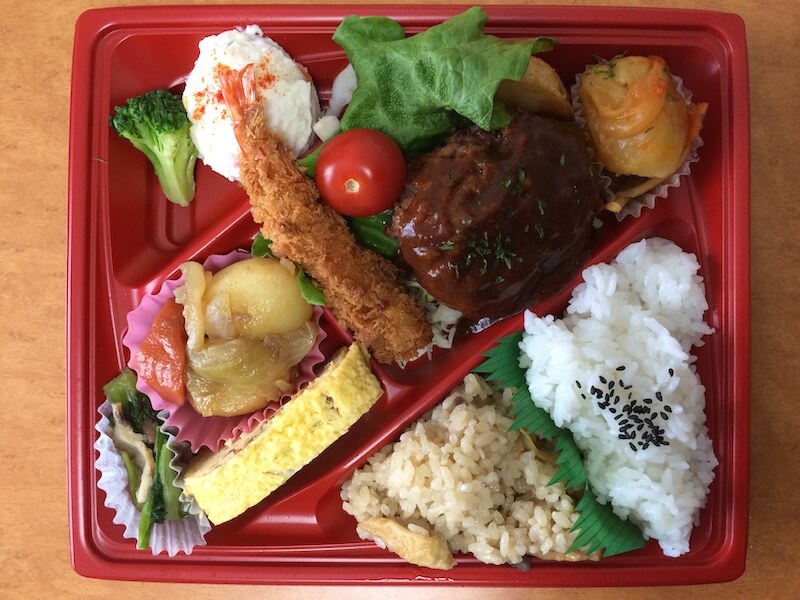
Bento boxes are prepackaged meals found at train stations, convenience stores, or department stores in Japan.
They come with an array of side dishes of meat, seafood, and/or vegetables.
49. Kaiseki (懐石)
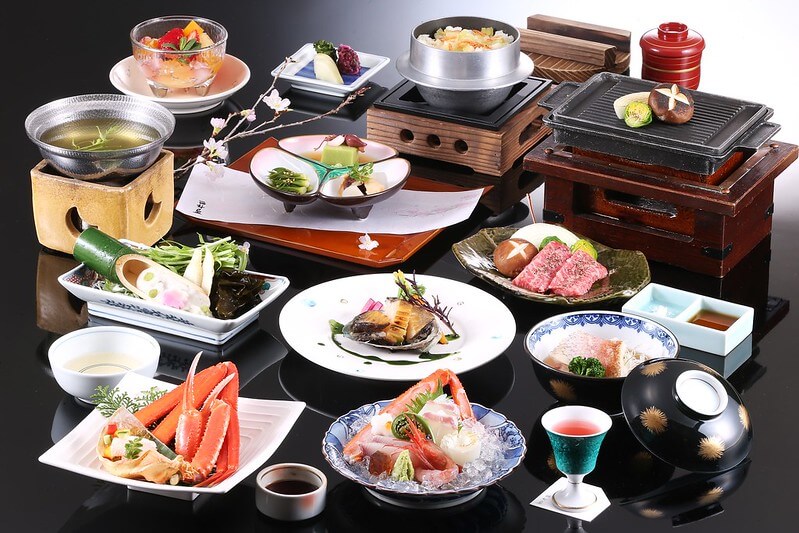
Kaiseki is an elaborate, traditional multi-course Japanese dinner.
The careful meal balances all aspects of the food such as taste, texture, appearance, as well as colors in order to present dishes that are not just refined in flavor but in design as well.
Today, kaiseki typically comes with an appetizer, sashimi, a simmered dish, a grilled dish, and then a steamed course.
No two items or cooking methods are repeated; each dish and its ingredients are unique.
The items come in a specific order, and the chef may add other dishes as they see fit.
50. Omakase (お任せ)
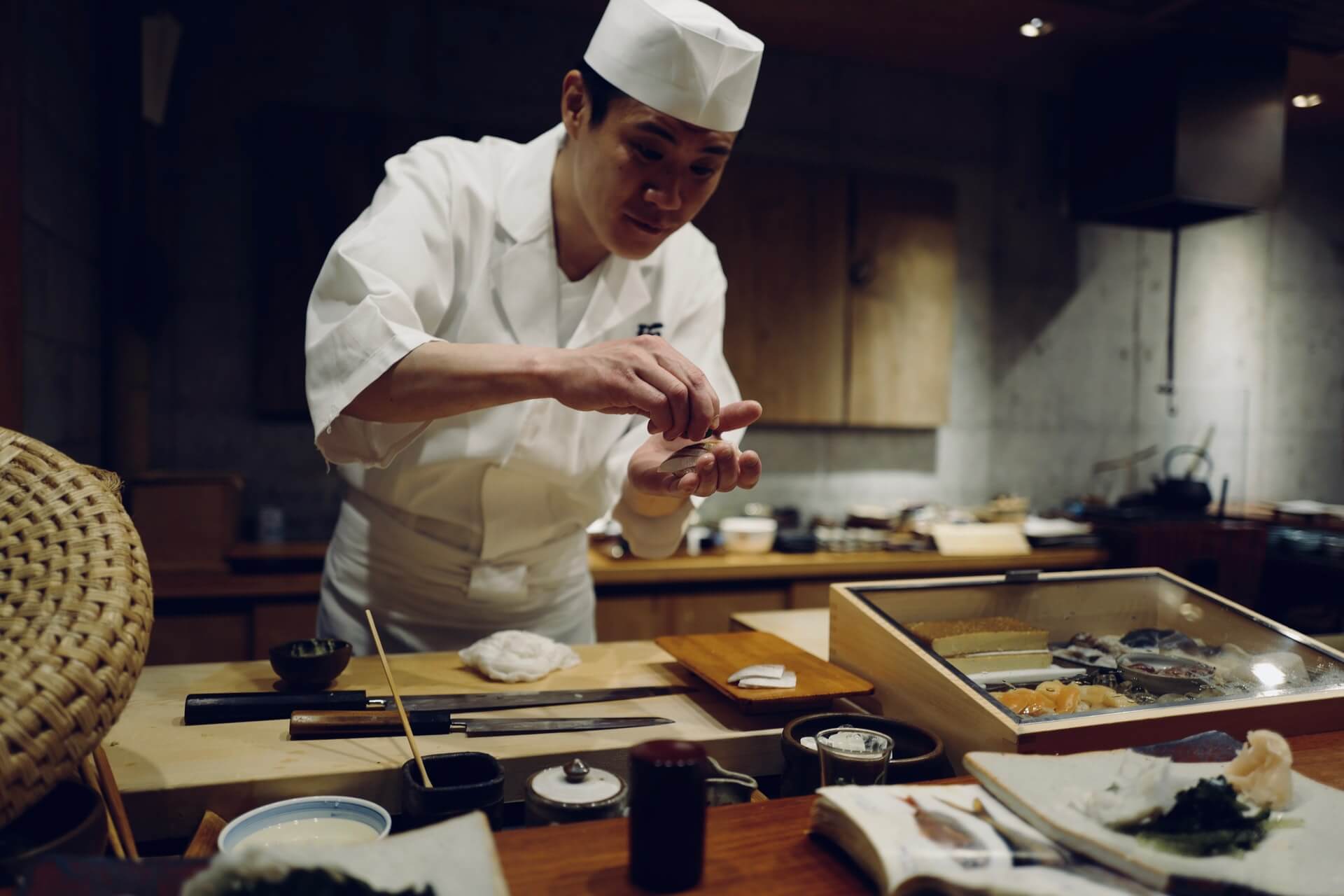
In Japanese, omakase translates to “I’ll leave it up to you.”
An omakase meal is when the diner allows the chef to select the dishes for the meal and there is no traditional menu.
This type of meal allows patrons to get a customized meal and unique experience from a culinary expert.
It’s a great way to try new dishes and ingredients you might not typically try or even know about!
The most popular type of omakase meal is omakase sushi, where the chef will prepare and serve seasonal fish based on the market’s selection that day.
However, there are other forms of omakase available as well.
As with any multi-course meal, and in addition to the specialized experience, omakase meals are understandably on the pricier side.
But if you’re looking to experience a truly memorable once in a lifetime, “when in Japan” dinner and an omakase meal is in your budget, you can’t go wrong with trusting the experts to serve you right.
Related Posts:
- 250+ Best Japan Captions for Instagram
- Does it Snow in Tokyo? When & What to Expect in Winter
- Does It Snow in Kyoto? When & What to Expect in Winter
- Essential Japan Winter Clothes: Your Ultimate Packing Guide
- How I Got Paid to Live in Japan: My Experience Teaching ESL in Japan
- Everything You Need to Know About Visiting Okunoshima Rabbit Island
Pin and Save
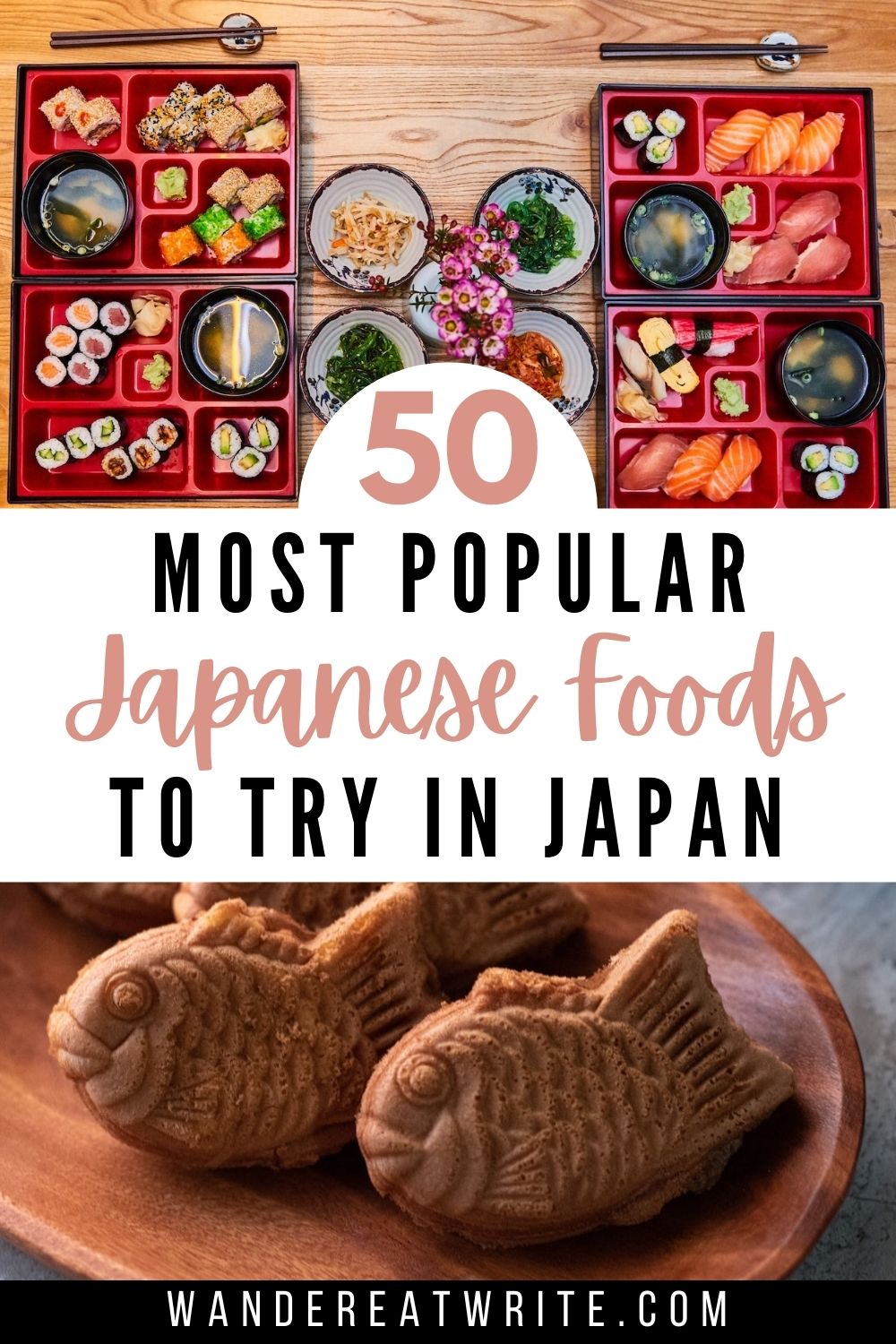

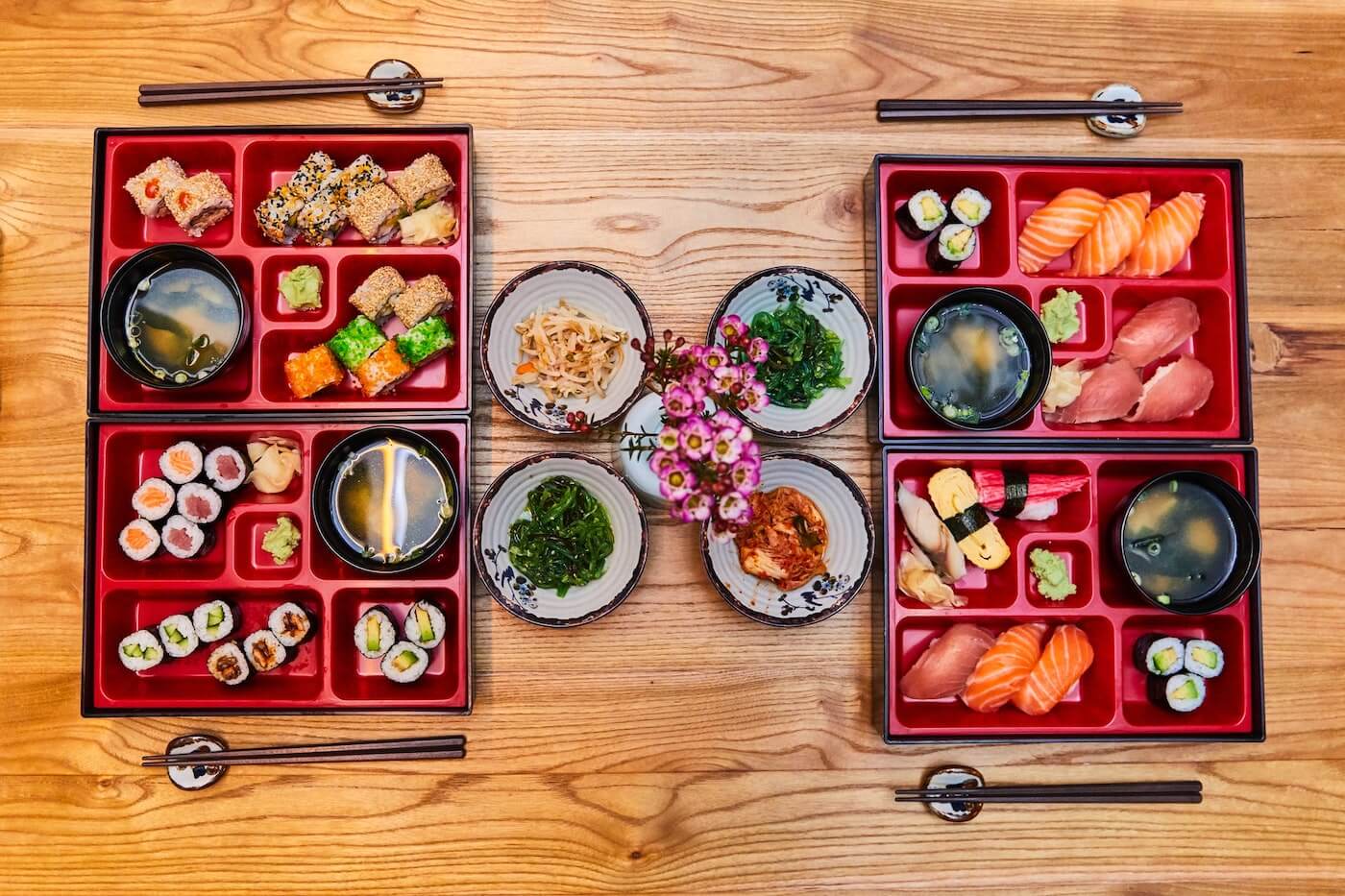
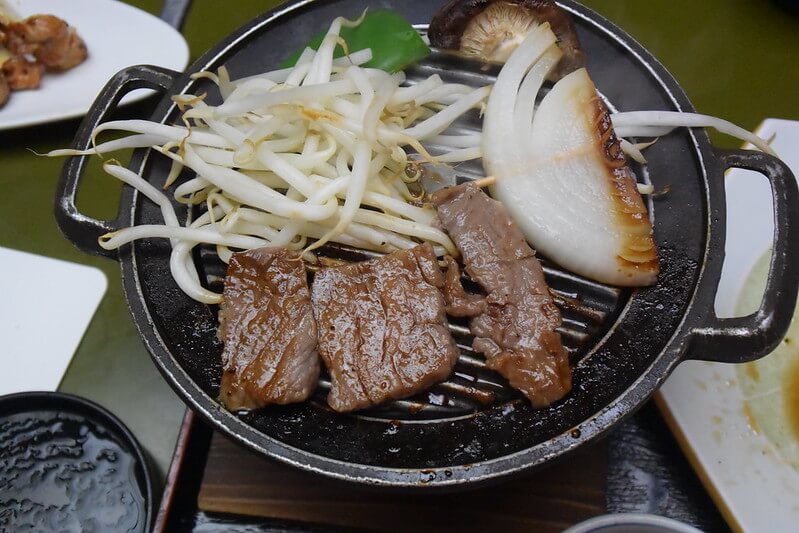
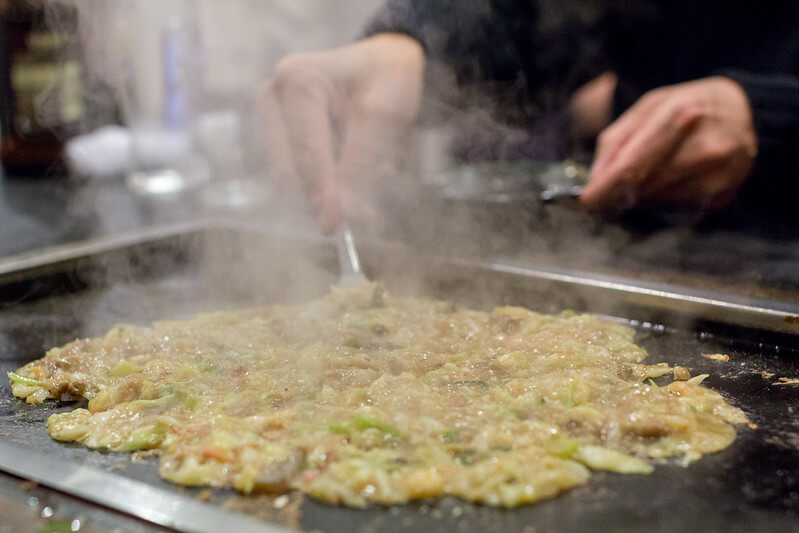
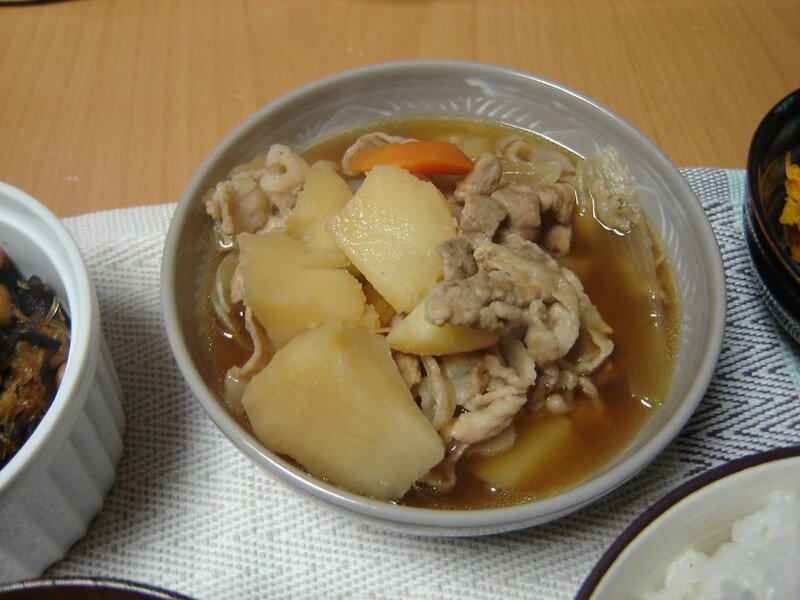

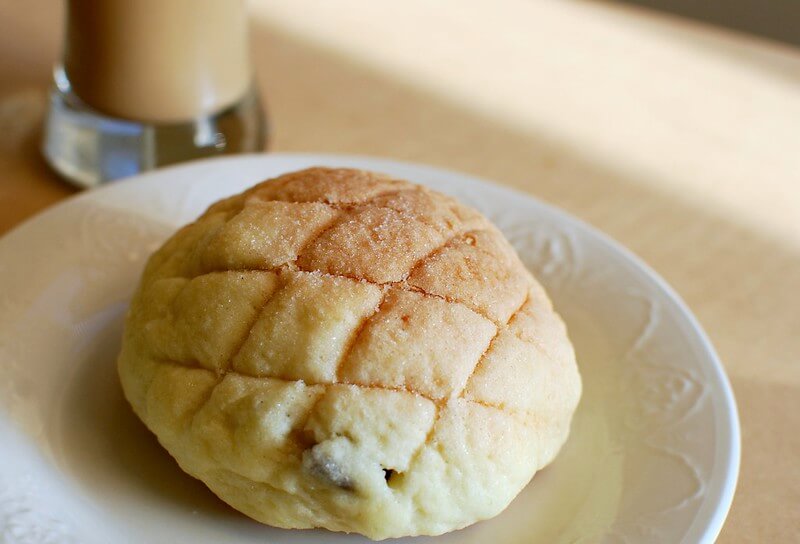
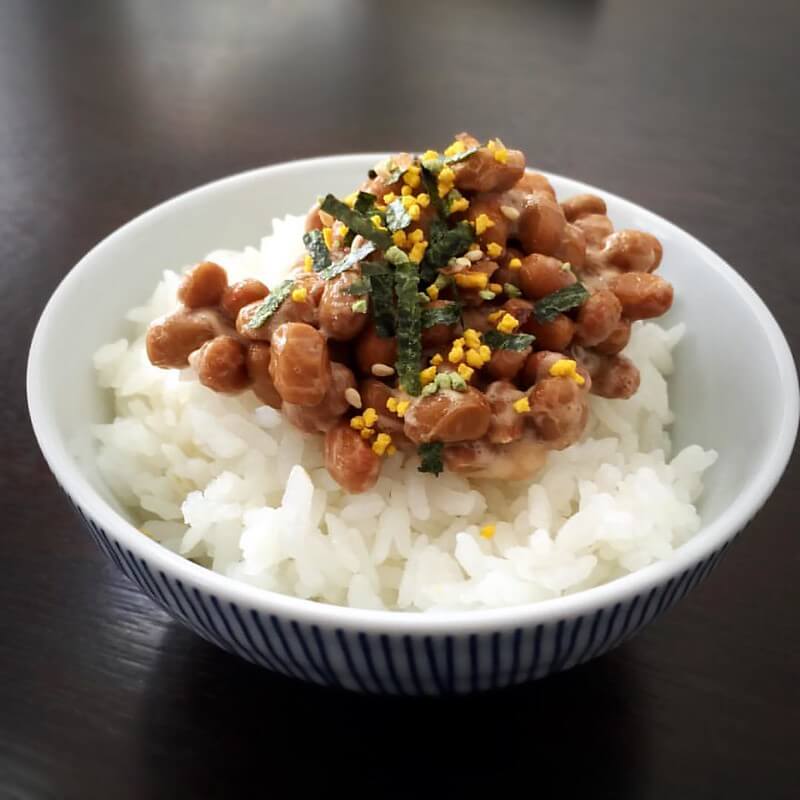
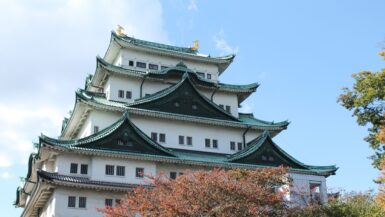
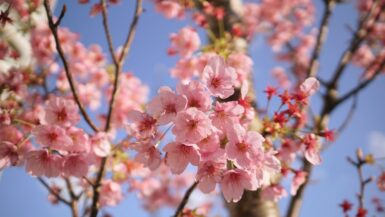

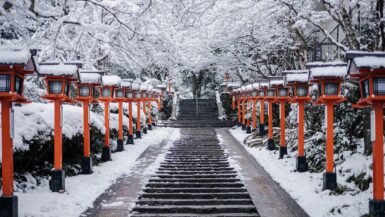
Leave a reply